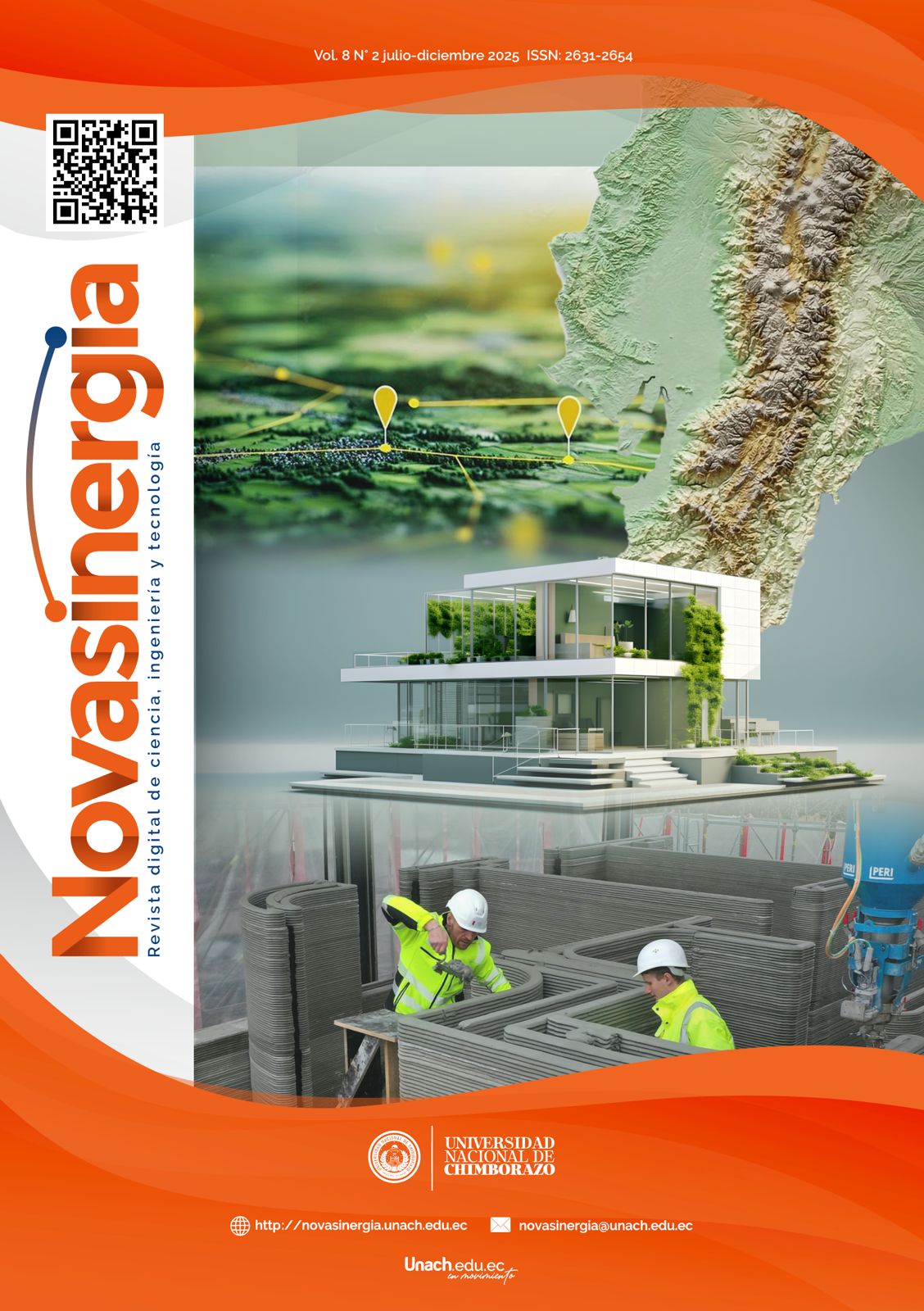Influence of the maximum hourly coefficient in the design of potable water reservoir tanks in Riobamba
DOI:
https://doi.org/10.37135/ns.01.16.02Keywords:
drinking water , hourly consumtion coefficient (Kh), storage, distribution networks, reserve tanksAbstract
Water scarcity, a global problem affecting many cities, is exacerbated by population growth, pollution of water sources, climate change, and increased demand. Storage tanks, structures designed to regulate pressure and store the necessary flow during peak demand, are crucial to ensure a continuous supply. This study analyzes the influence of the maximum hourly coefficient (Kh) in the design of storage tanks for the canton of Riobamba. For this purpose, the maximum hourly coefficients of previous investigations were verified, information was collected from the potable water systems, and the filling and emptying levels were recorded, with hourly measurements during seven days, of the nine existing storage tanks. The design of the tanks considered regulating emergency and fire volumes. The results revealed that the Maldonado network tank does not meet the current demand, generating shortages in the Maldonado and San Martín de Veranillo networks. In addition, a 15-year projection (up to 2039) indicates that seven of the nine systems will not have sufficient capacity to meet future demand.
Downloads
References
.[1] S. E. Martinez, O. Escolero, y L. Wolf, “Total Urban Water Cycle Models in Semiarid Environments-Quantitative Scenario Analysis at the Area of San Luis Potosi, Mexico”, Water Resources Management, vol. 25, núm. 1, pp. 239–263, ene. 2011, doi: https://doi.org/10.1007/s11269-010-9697-6.
.[2] J. Wang, C. Zha, W. Wang, G. Chen, y L. Liu, “Simulation-based optimization of urban water storage tank operations: Balancing hydraulic stability, water quality, and energy conservation”, Journal of Water Process Engineering, vol. 71, p. 107162, mar. 2025, doi: https://doi.org/10.1016/j.jwpe.2025.107162.
.[3] GAD Riobamba, “Plan de Desarrollo y Ordenamiento Territorial”, Riobamba, núm. 622, pp. 348–358, 2019.
.[4] EP EMAPAR, “Plan de desarrollo y ordenamiento territorial”, Riobamba, núm. 309, pp. 64–82, 2020. [En línea]. Disponible en: https://www.epemapar.gob.ec/wp-content/uploads/2017/03/plandesarrollocantonal.pdf. [Consultado: 25 de septiembre de 2024]
.[5] A. Arellano y D. Peña, “Modelos de regresión lineal para predecir el consumo de agua potable”, Novasinergia,vol. 3, núm. 1, pp. 27–36, 2020, doi: https://doi.org/10.37135/ns.01.05.03.
.[6] J. Saire, “Evaluación de los coeficientes de variación de consumo horario y diario en las líneas de interconexión de los reservorios del sistema Vilcanota-Cusco”, tesis, Universidad Andina del Cusco, Cusco, Cusco, 2015, [En línea]. Disponible en: https://www.researchgate.net/publication/321479965_evaluacion_de_los_coeficientes_de_variacion_de_consumo_horario_y_diario_en_las_lineas_de_interconexion_de_los_reservorios_del_sistema_vilcanota-cusco. [Consultado: 7 de octubre de 2024].
.[7] INEN CPE5, “Normas para estudio y diseño de sistemas de agua potable y disposición de aguas residuales para poblaciones mayores a 1000 habitantes”, 1992. [En línea]. Disponible en: www.pdffactory.com
.[8] L. Alulema y H. Estrada, “Estudio del consumo horario residencial de agua potable en las redes Saboya; Veranillo; Maldonado; Piscín de la ciudad de Riobamba.”, tesis, Universidad Nacional de Chimborazo, Riobamba, 2023. [En línea]. Disponible en: http://dspace.unach.edu.ec/handle/51000/10919. [Consultado: 26 de junio de 2024]
.[9] J. Avalos y G. Oleas, “Estudio del comportamiento horario residencial de agua potable en el cantón Riobamba.”, tesis, Universidad Nacional de Chimborazo, Riobamba, 2023, [En línea]. Disponible en: http://dspace.unach.edu.ec/handle/51000/11164. [Consultado: el 26 de junio de 2024]
.[10] Organización Panamericana de la Salud (OPS), “Guías para el diseño de reservorios elevados de agua potable”, Lima, 2005. [En línea]. Disponible en: https://sswm.info/sites/default/files/reference_attachments/OPS%202005c%20Revervorios%20elevados.pdf. [Consultado: 4 de noviembre de 2024]
.[11] H. Shemer, S. Wald, y R. Semiat, “Challenges and Solutions for Global Water Scarcity”, Membranes, vol. 6, num. 1, pp. 612, 2023, doi: https://doi.org/10.3390/membranes13060612.
.[12] S. C. Olisa, C. N. Asiegbu, J. E. Olisa, B. O. Ekengwu, A. A. Shittu, y M. C. Eze, “Smart two-tank water quality and level detection system via IoT”, Heliyon, vol. 7, núm. 8, p. e07651, ago. 2021, doi: https://doi.org/10.1016/j.heliyon.2021.e07651.
.[13] M. Kalamani, S. B. Sakthi Sri, G. G. Sugan, S. R. Edward Bensteve, y P. Rajkumar, “Automation of water tank management system for residential Areas”, Mater Today Proc, vol. 62, pp. 2388–2391, 2022, doi: https://doi.org/10.1016/j.matpr.2022.04.981.
.[14] Y. Ban et al., “Intensification of water scarcity threatens future food security in northwestern China”, J Hydrol Reg Stud, vol. 58, p. 102177, abr. 2025, doi: https://doi.org/10.1016/j.ejrh.2025.102177.
.[15] H. P. Estrada Vizuete, “Design of the Potable Water System for the Parish of El Rosario, Canton Guano, Province of Chimborazo, Ecuador.” tesis, Universitat Politècnica de València, Valencia, 2019. [En línea]. Disponible en: https://riunet.upv.es/handle/10251/120454
.[16] A. Arellano, A. Bayas, A. Meneses, y T. Castillo, “Los consumos y las dotaciones de agua potable en poblaciones ecuatorianas con menos de 150 000 habitantes”, Novasinergia, vol. 1, núm. 1, pp. 23–32, jun. 2018, doi: https://doi.org/10.37135/unach.ns.001.01.03.
.[17] I. K. Tumwebaze et al., “Access to and factors influencing drinking water and sanitation service levels in informal settlements: Evidence from Kampala, Uganda”, Habitat Int, vol. 136, p. 102829, jun. 2023, doi: https://doi.org/10.1016/j.habitatint.2023.102829.
.[18] D. Llanos, “Determinación de los coeficientes reales de variación de consumo diario (K1) y horario (K2) para mejorar futuros diseños de obras de saneamiento del Sub Sector 24 de la ciudad de Tacna”, tesis, Universidad Privada de Tacna, Perú, 2021. [En línea]. Disponible en: http://repositorio.upt.edu.pe/handle/20.500.12969/1865
.[19] M. K. Srivastava, S. Gaur, A. Ohri, P. K. Srivastava, y N. Singh, “Applications of remote sensing in water quality assessment”, Remote Sensing in Precision Agriculture, pp. 217–236, ene. 2024, doi: https://doi.org/10.1016/B978-0-323-91068-2.00019-9.
.[20] L. Lin, H. Yang, y X. Xu, “Effects of Water Pollution on Human Health and Disease Heterogeneity: A Review”, Front. Environ. Sci., vol. 10, jun. 2022, doi: https://doi.org/10.3389/fenvs.2022.880246.
.[21] B. J. Singh, A. Chakraborty, y R. Sehgal, “A systematic review of industrial wastewater management: Evaluating challenges and enablers”, J Environ Manage, vol. 348, p. 119230, dic. 2023, doi: https://doi.org/10.1016/j.jenvman.2023.119230.







